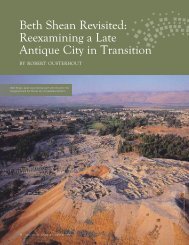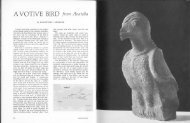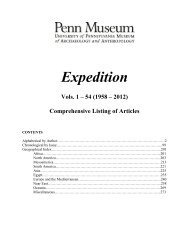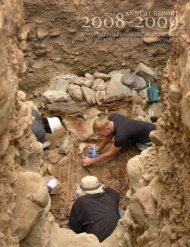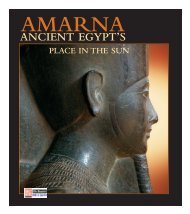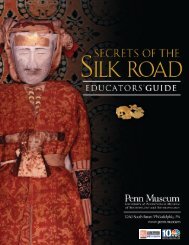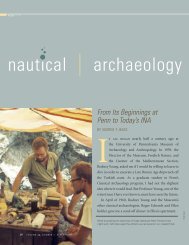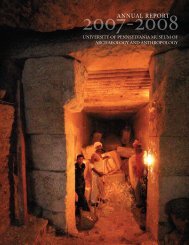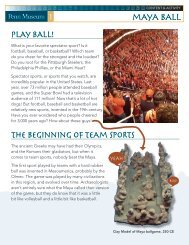butrint Putting Together a City's History by Studying Its Walls
butrint Putting Together a City's History by Studying Its Walls
butrint Putting Together a City's History by Studying Its Walls
You also want an ePaper? Increase the reach of your titles
YUMPU automatically turns print PDFs into web optimized ePapers that Google loves.
Andrew Crowson<br />
The results of our survey, combined with continuing<br />
research conducted <strong>by</strong> the Butrint Foundation, suggest<br />
that the main phases of the Butrint castle did not begin<br />
with a Hellenistic, or even a Byzantine, walled citadel as<br />
previously thought. Instead, they began with a poorly<br />
preserved later castrum or fortress (13th, possibly<br />
11th century AD) at the west end of the acropolis. This<br />
was part of the major wall-building program that we<br />
have labeled Medieval Phase I. Access to the acropolis<br />
seems to have been quite open during this phase with<br />
a possible major entrance located along the southern<br />
acropolis wall. This fortification system was strengthened<br />
during the 13th to 14th centuries as part of an<br />
effort that reconfigured the access routes to the acropolis<br />
and closed off the northern area of the promontory<br />
as well as any direct passages between this area and the<br />
acropolis. Rather than a third phase of construction<br />
during the 16th century under the Venetians, as originally<br />
assumed, the citadel, it now appears, was actually<br />
deserted during this period in favor of a Venetian<br />
tower and triangular castle on the northern and southern sides<br />
of the Vivari Channel, respectively. The triangular castle was<br />
strengthened in the 18th century and became the center of an<br />
Ottoman settlement in the early 19th century. In the end, this<br />
more general picture of continual demographic change in and<br />
around Butrint matches the image that is emerging of the premedieval<br />
city from more targeted excavations being carried out<br />
around the area of the Roman forum and on the Vrina Plain.<br />
Throughout its history, the city inhabitants reconfigured, replanned,<br />
and restructured access to Butrint and its environs to<br />
meet contemporary challenges, just as those who have recently<br />
taken the city under their care continue to do today.<br />
james g. schryver is Assistant Professor of Art <strong>History</strong> at<br />
the University of Minnesota, Morris. Over the last 13 years, he<br />
has led or participated in archaeological excavations around<br />
the Mediterranean and in Ireland. He assures us that he still<br />
loves puzzles.<br />
For Further Reading<br />
Crowson, Andrew. Venetian Butrint. London: Butrint Foundation, 2007.<br />
Gilkes, Oliver J., ed. The Theatre at Butrint: Luigi Maria Ugolini’s<br />
Excavations at Butrint 1928–1932 (Albania antica IV). London: British<br />
School at Athens, 2003.<br />
Right, photo of the author (left) with Gjerak Karaiskaj<br />
on the day of their tour around the city walls.<br />
Hansen, Inge Lyse, and Richard Hodges, eds. Roman Butrint: An<br />
Assessment. Oxford: Oxbow, 2007.<br />
Hodges, Richard. “Byzantine Butrint: New Discoveries from Albania.”<br />
Current World Archaeology 26 (2007):56-60.<br />
Hodges, Richard. The Rise and Fall of Byzantine Butrint. London:<br />
Butrint Foundation, 2008.<br />
Hodges, Richard, and Matthew Logue. “The Mid-Byzantine Re-birth of<br />
Butrint.” Minerva 18-3 (2007):41-43.<br />
Hodges, Richard, William Bowden, and Kosta Lako, eds. Byzantine<br />
Butrint: Excavations and Surveys 1994–1999. Oxford: Oxbow, 2004.<br />
Acknowledgments<br />
Left, one of the earlier<br />
gates into the city<br />
(Medieval Phase I), which<br />
was blocked as a result of<br />
subsequent repairs to the<br />
city walls (Medieval Phase<br />
II), that further restricted<br />
and re-routed the flow of<br />
traffic to the citadel.<br />
The author would like to thank the Butrint Foundation for their invitation<br />
and assistance on site and the Venetian Heritage Inc. and Packard<br />
Humanities Institute for funding this study. The main archaeological<br />
assessment was made from May 12 to May 29, 2004. Further archival<br />
research was conducted <strong>by</strong> the author during the summer of 2006.<br />
The principal investigators were Andrew Crowson (Institute of World<br />
Archaeology [IWA], UEA, Norwich, UK) and James G. Schryver (University<br />
of Minnesota, Morris). Crowson and Schryver were aided <strong>by</strong> Matthew<br />
Logue (National University of Ireland [NUI] – Galway). They were supported<br />
<strong>by</strong> Professor Richard Hodges (Scientific Director, Butrint Foundation)<br />
and Professor Gjerak Karaiskaj (Director, now retired, Institute of<br />
Monuments, Albania). The team was assisted <strong>by</strong> Nevila Molla (IWA).<br />
www.penn.museum/expedition 17




